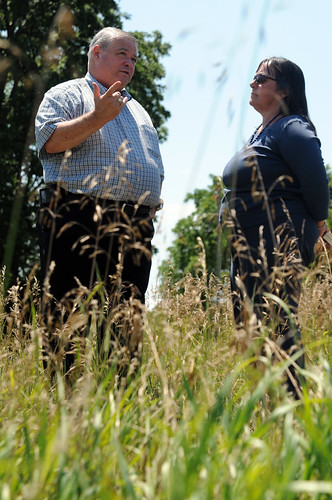This is Part I of a five-part series documenting the travels of Kentucky Guard Command Historian, John Trowbridge as he explores Kentucky’s participation in the War of 1812.
Story and photos by Sgt. David Bolton, Kentucky National Guard Public Affairs Office
[caption id="" align="alignright" width="239"]

Kentucky National Guard State Command Historian John Trowbridge and Lisa Gilbert, chair of the Friends of Tecumseh monument discuss the significance of the role that the Kentucky militia played in the War of 1812 at the Thames Battlefield in Chatham-Kent, Ontario July 9, 2012. (Kentucky National Guard photo by Sgt. David Bolton, 133rd Mobile Public Affairs Detachment)
BRANTFORD, Ontario -- For years, service members of the Kentucky National Guard have stood ready to answer the call of people of the state, as well as the nation. Now, 200 years later, the Kentucky Guard is remembering the service, sacrifice, and solidarity of those individuals who answered the same call to action during the War of 1812.
To see more photo from this story, click here
Documenting the history of the Kentucky militia and their role in the War of 1812 fell to Kentucky National Guard Command Historian John Trowbridge. Trowbridge, a retired Army veteran, traveled to Canada to work with other historians in order to paint a more complete picture of the involvement of Kentucky’s Guardsmen.
Trowbridge said, “Anytime you can work with another historian it is valuable because it gives us another avenue to research.”
Several historical sites were visited during the excursion to Ontario, Canada. Stops included: Brantford, the site of Malcolm’s Mill battle, Chatam-Kent, where the battlefields of Longwoods and Thames are located, and where, supposedly, the remains of two Kentucky militiamen are buried at Tecumseh Park.
An early version of the current U.S. flag with 15 stars and stripes was The Star-Spangled Banner. The fifteenth star emblazoned on the flag represented the last state to be made part of the nation since the Revolutionary War, Kentucky. This flag was to be the banner carried by U.S. forces at battles that spanned as far south as New Orleans and as far north as Brantford. Even though Kentucky was the last state to be put on the flag, it was the first to allow its militia to cross state and international boundaries.
But the patriotism of offering so many troops to the war efforts did not come without a price. Trowbridge noted that of the 2,260 Americans killed in the War of 1812, 64% of the casualties were Kentuckians.
“It’s a great experience to get to read about these things and then get to see what our guys saw in 1812,” said Trowbridge. “This is a unique opportunity because, until you get on the ground where those individuals stood, you can’t really appreciate it.”
[caption id="" align="alignleft" width="350"]

Historians from Kentucky and Canada, as well as local Canadian contributing members, review documents which may lead to the possible burial sites of Pvt. William Hardwick and Pvt. Foster Bartlett, two Kentucky militia service members who were killed during the War of 1812. The meeting took place at the old armory at Tecumseh Park in Chatham-Kent, Ontario July 9, 2012. (Kentucky National Guard photo by Sgt. David Bolton, 133rd Mobile Public Affairs Detachment).
The research being done isn’t about the differences between the British and the American forces, however. The focus is on understanding the impact and evaluating the importance of the Kentucky militia during the war.
“We’re not here to celebrate a war that happened 200 years ago,” said Trowbridge. “The focus is on remembering and honoring those who served on both sides of the conflict and the 200 years of peace that our countries have enjoyed since that time.”
In addition to traveling to Canada, Trowbridge also followed the Kentucky militiamen’s movements through the northern states of Michigan, Indiana, and Ohio. These locations will be explored in upcoming installments.